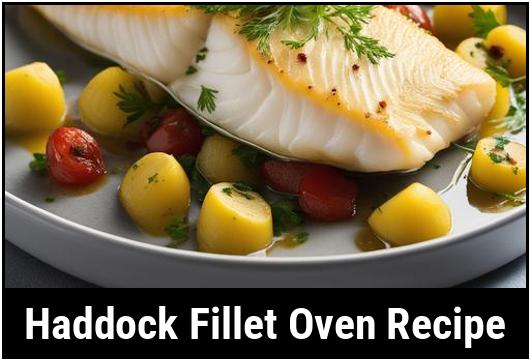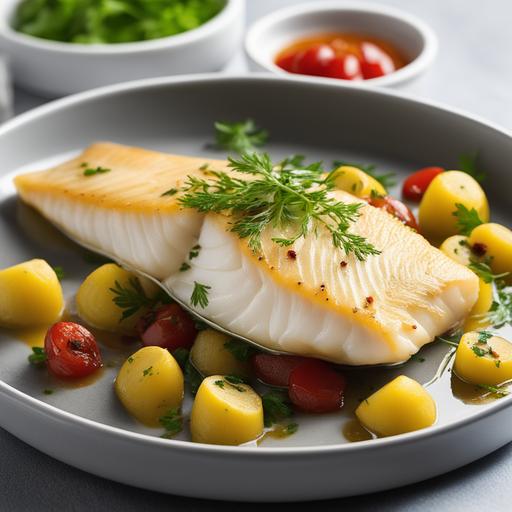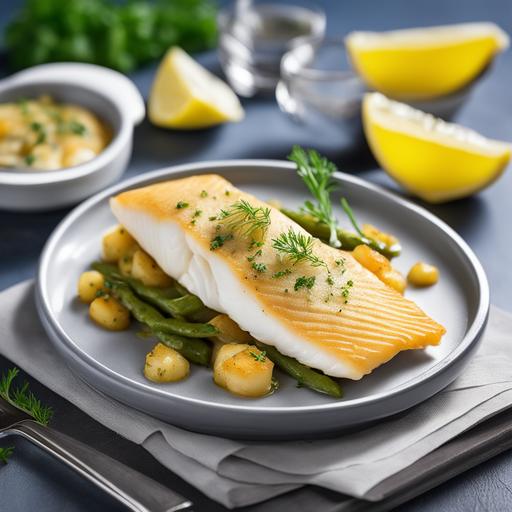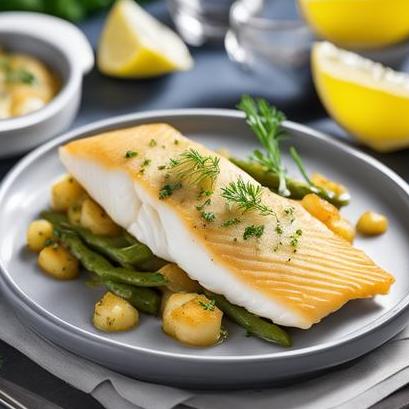
Haddock Fillet Oven Recipe: The Ultimate Guide To A Delectable Dish
Haddock, a member of the cod family, is a popular choice for seafood enthusiasts due to its mild flavor and delicate texture. Cooking haddock fillets in the oven is a simple yet effective way to preserve their natural taste and ensure a moist, flaky result. In this comprehensive guide, we’ll delve into the food science behind cooking haddock fillets in the oven, discuss how to choose the best ingredients, explore the preparation process, determine the optimal oven temperature and timing, and finally, provide a detailed recipe for creating a delicious haddock fillet dish.
Food Science Of Cooking Haddock Fillet In An Oven
Understanding the food science behind cooking haddock fillets in the oven is essential for achieving the perfect result. Haddock, like many other types of fish, contains proteins that undergo structural changes when exposed to heat. These proteins coagulate, causing the fish to become firm and opaque as it cooks. Overcooking can lead to dryness and toughness, while undercooking may result in a raw, unpleasant texture.
The oven provides a gentle, even heat that cooks the haddock fillets uniformly, preserving their moisture and tenderness. By controlling the temperature and cooking time, you can achieve the ideal balance between doneness and succulence.
Choosing Ingredients
Selecting high-quality ingredients is crucial for preparing a delicious haddock fillet dish. When choosing haddock fillets, look for fresh or frozen options that are firm, translucent, and free from any strong odors. Fresh haddock should have a clean, briny smell reminiscent of the ocean.
Additionally, consider the seasoning and flavorings you’ll use to enhance the natural taste of the haddock. Fresh herbs such as dill, parsley, or thyme can add brightness and aroma, while lemon zest or juice provides acidity and zestiness. Quality olive oil or melted butter adds richness and helps prevent the fish from sticking to the pan.
Preparing Ingredients

Proper preparation is key to ensuring that your haddock fillets cook evenly and retain their moisture. Begin by thawing frozen fillets in the refrigerator overnight if necessary. Once thawed, pat the fillets dry with paper towels to remove any excess moisture, which can inhibit browning and promote steaming.
Next, season the haddock fillets generously with salt and pepper, ensuring that both sides are evenly coated. For added flavor, you can sprinkle them with herbs, spices, or citrus zest. Allow the seasoned fillets to rest at room temperature for 10-15 minutes before cooking to allow the flavors to penetrate the fish.
Optimal Oven Cooking Temperature & Timing
Achieving the perfect balance of temperature and timing is crucial for cooking haddock fillets in the oven. Preheat your oven to 375°F (190°C) to ensure that it reaches the desired temperature before adding the fish. This moderate heat allows the fillets to cook gently without drying out or becoming overdone.
As a general rule, plan for approximately 10 minutes of cooking time per inch of thickness for haddock fillets. For example, a 1-inch thick fillet would require around 10-12 minutes in the oven. However, cooking times may vary depending on the size and thickness of the fillets, so it’s essential to monitor them closely to prevent overcooking.
Haddock Fillet Oven Recipe
Now that we’ve covered the fundamentals, let’s dive into a detailed recipe for cooking haddock fillets in the oven:
Ingredients
- 4 haddock fillets (6 ounces each), fresh or thawed
- 2 tablespoons olive oil or melted butter
- Salt and freshly ground black pepper, to taste
- 2 tablespoons fresh herbs (such as dill, parsley, or thyme), chopped
- 1 lemon, thinly sliced
Instructions
-
Preheat your oven to 375°F (190°C) and lightly grease a baking dish or sheet pan with olive oil or non-stick cooking spray.
-
Pat the haddock fillets dry with paper towels and season them generously with salt and pepper on both sides.
-
Place the seasoned fillets in the prepared baking dish, ensuring that they are spaced evenly apart to allow for even cooking.
-
Drizzle the fillets with olive oil or melted butter, then sprinkle them with the chopped fresh herbs.
-
Arrange the lemon slices on top of the fillets, placing them directly on the fish for added flavor.
-
Transfer the baking dish to the preheated oven and bake the haddock fillets for 10-12 minutes, or until they are opaque and flake easily with a fork.
-
Once cooked, remove the baking dish from the oven and allow the fillets to rest for a few minutes before serving.
-
Serve the haddock fillets hot, garnished with additional fresh herbs and lemon wedges if desired. Enjoy!
Cooking haddock fillets in the oven is a simple yet rewarding process that yields tender, flavorful results every time. By understanding the food science behind the cooking process, selecting high-quality ingredients, and following a few key steps, you can create a delicious seafood dish that’s sure to impress your family and friends. Whether you’re hosting a dinner party or preparing a weeknight meal, this haddock fillet oven recipe is sure to become a favorite in your culinary repertoire.
Doneness Checks

Haddock is a versatile and flavorful fish that lends itself well to various cooking methods, including baking in the oven.
Before we delve into the recipe itself, it’s crucial to understand how to determine when your haddock fillets are perfectly cooked. Here are some doneness checks to keep in mind:
-
Internal Temperature: Use a meat thermometer to check the internal temperature of the thickest part of the fillet. Haddock is cooked through when it reaches an internal temperature of 145°F (63°C).
-
Flakiness: Gently insert a fork into the thickest part of the fillet and twist it slightly. If the flesh flakes easily and is opaque all the way through, it’s done.
-
Color and Texture: Cooked haddock should have a white, opaque appearance with a firm texture. Avoid translucent or rubbery flesh, as these are signs of undercooking or overcooking.
Undercooking
Undercooking haddock can result in a raw, unpleasant texture and flavor. Here are some common signs of undercooked haddock:
-
Translucent Flesh: If the flesh of the haddock fillet is still translucent and slightly translucent after cooking, it’s likely undercooked.
-
Resistance to Flaking: Undercooked haddock will be resistant to flaking with a fork and may appear slightly rubbery.
To prevent undercooking, ensure that the haddock fillets reach an internal temperature of 145°F (63°C) and that they flake easily with a fork.
Overcooking
Overcooking haddock can lead to dry, tough, and flavorless fish. Here are some indicators that your haddock fillets may be overcooked:
-
Dry Texture: Overcooked haddock will have a dry, stringy texture and may appear shriveled or shrunken.
-
Burnt Edges: If the edges of the haddock fillets are burnt or excessively browned, they may be overcooked.
To avoid overcooking, monitor the cooking time closely and remove the haddock from the oven as soon as it reaches an internal temperature of 145°F (63°C). Additionally, avoid cooking haddock at too high a temperature, as this can cause it to cook too quickly on the outside while remaining undercooked on the inside.
Troubleshooting

Encountering issues during the cooking process is common, but with the right techniques, you can troubleshoot and salvage your dish. Here are some troubleshooting tips for common haddock cooking problems:
-
Dry Fillets: If your haddock fillets turn out dry, try basting them with melted butter or olive oil halfway through the cooking process to help retain moisture.
-
Sticking to the Pan: To prevent haddock fillets from sticking to the baking dish, line the dish with parchment paper or aluminum foil and lightly grease it with cooking spray or oil.
-
Uneven Cooking: If some parts of the haddock fillets are cooked more than others, try covering the dish with foil halfway through the cooking time to prevent the exposed areas from drying out too quickly.
-
Fishy Odor: If your haddock fillets have a strong fishy odor, it could be a sign that they are not fresh. Always purchase fresh fish from a reputable source and cook it as soon as possible to ensure optimal flavor.
By implementing these troubleshooting techniques, you can overcome common cooking challenges and achieve perfectly cooked haddock fillets every time.
Recipe Variations
Now that you’re familiar with the basics of cooking haddock fillets in the oven, let’s explore some delicious recipe variations to add variety to your meals:
-
Herb-Crusted Haddock: Coat the haddock fillets in a mixture of breadcrumbs, Parmesan cheese, and chopped fresh herbs such as parsley, thyme, and rosemary. Bake in the oven until golden and crispy.
-
Lemon Garlic Haddock: Drizzle the haddock fillets with olive oil and sprinkle with minced garlic, lemon zest, and a squeeze of fresh lemon juice. Bake until the fish is cooked through and fragrant.
-
Pesto Baked Haddock: Spread a layer of basil pesto over the haddock fillets and top with sliced tomatoes and mozzarella cheese. Bake until the cheese is melted and bubbly.
-
Asian-Inspired Haddock: Marinate the haddock fillets in a mixture of soy sauce, ginger, garlic, and sesame oil. Serve with steamed rice and stir-fried vegetables for a flavorful Asian-inspired meal.
Feel free to experiment with different seasonings, marinades, and toppings to create your own unique haddock fillet recipes.
Cooking haddock fillets in the oven is a simple yet delicious way to enjoy this flavorful fish. By following the tips and techniques outlined in this article, you can ensure that your haddock fillets are perfectly cooked every time. Whether you prefer a classic preparation or want to try out some creative recipe variations, there are endless possibilities for enjoying haddock fillets as a nutritious and satisfying meal. So fire up your oven and get ready to impress your taste buds with mouthwatering haddock fillet dishes!
Flavour Enhancement Tips
Haddock is a member of the cod family and is known for its mild flavor and tender texture. It’s a popular choice for seafood lovers due to its versatility and ability to pair well with a variety of flavors. Baking haddock fillets in the oven is a simple yet effective way to prepare this fish, allowing you to infuse it with delicious seasonings and achieve a perfectly cooked result.
Enhancing the flavor of your haddock fillets is key to creating a memorable dish. Here are some tips to help you elevate the taste of your baked haddock:
Seasoning Blend
Create a custom seasoning blend using herbs, spices, and aromatics such as garlic, lemon zest, parsley, and dill. Mix these ingredients together with a bit of olive oil or melted butter to form a paste, which can be spread over the haddock fillets before baking.
Citrus Infusion
Add brightness to your haddock by incorporating citrus fruits such as lemon or lime. Squeeze fresh citrus juice over the fillets before baking or lay slices of lemon on top of the fish to infuse it with citrus flavor as it cooks.
Wine Or Stock
For an extra layer of flavor, consider adding a splash of white wine or fish stock to the baking dish. This will create a flavorful cooking liquid that will keep the haddock moist while infusing it with additional taste.
Texture Enhancement Tips

Achieving the perfect texture is essential when baking haddock fillets in the oven. Follow these tips to ensure your fish turns out tender and flaky:
Proper Thickness
Choose haddock fillets that are of uniform thickness to ensure even cooking. Thicker fillets may require slightly longer cooking times, while thinner fillets will cook more quickly.
Avoid Overcooking
Haddock is prone to drying out if overcooked, so be sure to monitor the cooking time closely. Remove the fillets from the oven as soon as they are opaque and easily flake with a fork.
Moisture Retention
To help the haddock retain moisture during baking, consider covering the baking dish with aluminum foil for the first portion of the cooking time. This will create a steamy environment that will prevent the fish from drying out.
Cooking At Different Temperatures
The cooking temperature plays a crucial role in the outcome of your baked haddock. Here’s how to adjust the temperature based on your desired results:
High Temperature (400°F – 450°F)
Baking haddock at a higher temperature will result in a crispier exterior while keeping the interior moist and flaky. This method is ideal for those who prefer a slightly charred and caramelized finish on their fish.
Moderate Temperature (350°F – 375°F)
Baking haddock at a moderate temperature will ensure gentle and even cooking, resulting in tender and juicy fillets. This method is perfect for those who prefer a more delicate texture and flavor.
Low Temperature (300°F – 325°F)
Baking haddock at a low temperature will result in a slower cooking process, allowing the fish to gently poach in its juices. This method is ideal for those who want to infuse the haddock with maximum flavor while maintaining its delicate texture.
Cooking Tips
Follow these additional tips to ensure success when baking haddock fillets in the oven:
Preheat The Oven
Always preheat your oven before placing the haddock fillets inside. This ensures that the fish cooks evenly and prevents it from drying out.
Use A Baking Dish
Arrange the haddock fillets in a single layer in a baking dish to ensure even cooking. Avoid overcrowding the fillets, as this can prevent them from cooking properly.
Test For Doneness
Use a fork to gently flake the thickest part of the haddock fillet to check for doneness. The fish should be opaque and flake easily when cooked through.
Serving Suggestions
Once your haddock fillets are perfectly baked, it’s time to serve them up in style. Here are some serving suggestions to complement your delicious fish:
Side Dishes
Pair your baked haddock with a variety of side dishes such as roasted vegetables, steamed rice, or buttery mashed potatoes. These accompaniments will add texture and flavor to your meal.
Sauces
Serve your haddock with a flavorful sauce such as hollandaise, tartar sauce, or a simple lemon butter sauce. These sauces will enhance the taste of the fish and add a luxurious touch to your dish.
Garnishes
Add a pop of color and freshness to your baked haddock with garnishes such as chopped parsley, dill, or chives. These herbs will not only enhance the presentation of your dish but also add a burst of flavor.
Conclusion
Baking haddock fillets in the oven is a simple and delicious way to prepare this versatile fish. By following the tips and techniques outlined in this guide, you can create a mouthwatering haddock dish that is sure to impress your family and friends. Experiment with different seasonings, cooking temperatures, and serving suggestions to customize the recipe to your tastes. With a little practice, you’ll be able to master the art of baking haddock fillets and enjoy a flavorful and satisfying meal every time.
FAQS
What Temperature Should I Preheat The Oven To For Cooking Haddock Fillets?
It is recommended to preheat the oven to 400°F (200°C) before cooking haddock fillets. This allows for even cooking and a crispy exterior.
How Long Should I Bake Haddock Fillets In The Oven?
Haddock fillets typically take around 12-15 minutes to cook in the oven at 400°F (200°C). It is important to check for doneness by inserting a fork into the thickest part of the fillet, and it should flake easily when done.
Can I Use Any Seasonings For My Haddock Fillet Oven Recipe?
Yes, you can use a variety of seasonings to enhance the flavor of haddock fillets in the oven. Some popular options include lemon pepper, garlic powder, paprika, and fresh herbs like parsley or dill.
Should I Cover The Haddock Fillets When Baking In The Oven?
It is not necessary to cover haddock fillets when baking them in the oven. The uncovered fillets will develop a crispy exterior while remaining moist and flavorful on the inside.
What Is The Best Way To Serve Haddock Fillets Cooked In The Oven?
Haddock fillets can be served with a variety of side dishes, such as roasted vegetables, steamed rice, or a fresh salad. Additionally, a squeeze of lemon juice or a dollop of tartar sauce can complement the flavors of the haddock fillets nicely.


